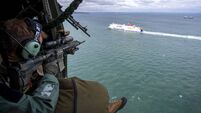America counts the cost of fighting an invisible enemy
THERE is a moment in the classic 1972 movie The Candidate when Bill McKay, the inexperienced and fresh-faced young lawyer played by Robert Redford, turns to his advisers just after he has won election to the US Senate and anxiously asks "What do we do now?" It is a question that is being asked with increasing frequency in Washington these days as the human and financial costs of American involvement in Iraq steadily rise nearly five months after US President George W Bush declared the end of major combat operations in Iraq.
Like McKay, few in the Bush administration appeared to have given much thought to what happens after the main event and now they are struggling for ways to understand and deal with the unfolding drama. It was all meant to be very different. Before the war, the neo-conservative hawks within the administration clearly believed that the post-war occupation what is known in Pentagon jargon as 'phase four' would be cheap and easy. Deputy Secretary of State Paul Wolfowitz told Congress: "We are dealing with a country that can... finance its own reconstruction, and relatively soon".
Vice-President Dick Cheney repeatedly stated American troops would be welcomed as liberators. The plans drawn up then envisaged fewer than 60,000 troops in Iraq at this time.
Instead, 130,000 troops are stationed in Iraq including 16 of the army's 33 combat brigades. Reservists the so-called weekend warriors who have another day job are being stretched close to breaking point as they face year-long tours of duty in the Middle East. The drip drip effect of casualties witnessed again yesterday with the death of eight US soldiers in Iraq is impacting on national morale while Mr Bush's request for an additional $87 billion to finance the occupation leaves Dr Wolfowitz looking very foolish indeed.
Senator Tom Harkin voiced the fears of an uneasy public when he evoked the ghosts of a conflict from times past. "This may not be Vietnam," he said, "but, boy, it sure smells like it. And every time I see these bills coming down for the money, it's costing like Vietnam, too."
It's easy to make the comparison but Vietnam might be the wrong analogy. There, the United States suffered 58,000 casualties whereas the total number of combat deaths for Afghanistan and Iraq combined is less than 300. In Vietnam the Americans engaged a well-led army on jungle terrain. In Iraq, the enemy, thought to be made up of Baathist remnants and foreign Jihadists, is loosely organised and ill-defined while urban warfare is the defining feature of combat operations. Finally, nobody is advocating an American withdrawal, the rallying cry for the protests against the war in Vietnam.
However, other historical analogies are being taken pretty seriously. Recently the Pentagon arranged a special showing of Gillo Pontecorvo's harrowing film The Battle of Algiers, for 40 of its military and civilian leadership. As the New York Times revealed, the extraordinary flyer advertising the event read: "How to win a battle against terrorism but lose the war of ideas. Children shoot soldiers at point blank range. Women plant bombs in cafés. Soon the entire Arab population builds to a mad fervour. Sound familiar?"
In Algeria, the French responded to their almost invisible enemy with the widespread use of torture, executions, and repressive aggression. This had the effect of bolstering support for the Algerian nationalists, the FLN, and scandalising the French public thus undermining the military for decades.
Washington is extremely anxious to avoid the mistakes that may lead to this appalling vista but while the administration would like to quietly shift to a new strategy others want to hold the authors of the present mess accountable.
Most politicians and analysts supported the war against Saddam Hussein's Iraq.
What angers them is the haphazard way the neo-conservatives laid the ground for the invasion, their hubristic optimism, and the gratuitous insulting of American allies that now makes internationalising the post war phase much more difficult. When Pentagon officials testified on Capitol Hill in favour of Mr Bush's request for $87bn several Senators vented their anger. The ageing Robert Byrd warned "Congress is not an ATM" while Carl Levin said the budgetary request was a "bitter pill to swallow".
The administration has also been shaken by criticism contained in a new book about Iraq, Reconstructing Eden, co-authored by General Thomas White who resigned as army secretary earlier this year following a well publicised disagreement with Donald Rumsfeld. Gen White says the lack of planning threatens to turn a major military victory into a potential humanitarian, political and economic disaster.
There is a realisation on all sides in Washington that regardless of what one thought of the war and most supported it in principle the US is now involved and cannot walk away without destabilising the region and handing the global terrorist networks that are now active in Iraq a major victory. This is a point of view that is particularly strongly held in the White House where it is an article of faith that casualty aversion in the 1990s in Somalia and the Balkans prompted al-Qaida to grow ever more bold.
Instead, Mr Bush is trying to internationalise the effort in order to ease the enormous financial and military burden on America. He also appears to be welcoming the violence as an opportunity to fight the Islamic Jihadists in a single setting. The question on everyone's lips is whether this staying power can survive 14 more months of bad news right up until presidential election day or will the political necessity of appeasing an already wary public cause a radical change in direction.
Tom Wright is a doctoral fellow in international relations at Georgetown University, Washington DC.














